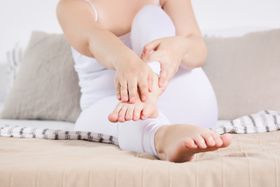Benefits of Yoga for Heel Pain
Learn more about how yoga can help you manage your heel pain and what poses you can do to help effectively reduce symptoms.
Published April 6, 2022
Heel pain is a common condition reported in people who experience pain in their feet. Pain usually occurs under the heel or towards the back where the Achilles tendon attaches to the heel. Achilles tendonitis, Achilles tendon bursitis, plantar fasciitis, or a heel spur are all potential causes of heel pain. These conditions can make exercises you might enjoy, such as weightlifting or cycling, a painful and unpleasant experience.
For many years, yoga has been used as a practice to increase strength, flexibility, and mental clarity. Yoga is a low impact form of exercise, and should not aggravate pain in the heel with repetitive practice. Yoga poses should be done with mindfulness and awareness of the body so as to not aggravate symptoms further.
Can Yoga Relieve Heel Pain?
People who are suffering from pain associated with plantar fasciitis will benefit from practicing yoga. However, yoga will not relieve your symptoms immediately and can take up to two years to fully resolve symptoms with regular practice.
Stretching the muscles of the feet and lower legs during yoga will lengthen the aggravated structures that may be contributing to heel pain. Yoga improves body alignment and strengthens the weakened muscles of the entire body.
Which Yoga Poses Are Good for Plantar Fasciitis?
Yoga should not aggravate symptoms of heel pain during or after practice. Instead, it should work to treat symptoms associated with plantar fasciitis gently and comfortably. Warrior poses or other poses that put a fair bit of weight on the heels may aggravate heel pain, and modifications can be made during practice to avoid this. To further relieve pressure on the heels while practicing yoga, use a thick yoga mat or double up on the one you already have.
Downward Facing Dog
This pose helps stretch the muscles in your calf and in the soles of your feet. This pose will also allow you to apply a gentle stretch to the other muscles of behind your legs.
Mountain Pose (Tadasana)
Standing with your hands at your side, being mindful of the distribution of weight through the entirety of the feet, reach up to the ceiling. One can also practice lifting the toes while placing the weight evenly through the ball of the feet and heels.
Utkatasana (Chair Pose)
Standing with your feet facing forward, about shoulder width apart, bend the knees slowly as if you're sitting on a chair with your arms held overhead. This will strengthen the feet and apply a gentle stretch to the calf muscles and muscles of the foot.
Vajrasana (Thunderbolt Pose) With Toes Flexed
Modify the normal thunderbolt pose by tucking the toes under your feet and stretching the soles of the feet. The stretch should be applied gradually and equally to both feet.
Paschimottanasana (Seated Forward Bend)
Sitting with your legs out in front of you, reach up and hinge at the hips to apply a stretch to the back of your legs. Reach for your toes as the stretch continues. Lengthening your leg muscles will improve mobility and limit pain or discomfort arising from these structures.
Other home remedies can be coupled with yoga practice for effective pain relief. Rest, ice, self-massage with gels or ointments, and orthotics are examples of other ways you can try to manage your heel pain at home.
Related Articles

Pain After Wearing Orthotics: Reasons and How to Stop It
Upstep Staff
July 10, 2025

Magnesium for Plantar Fasciitis: How It Can Relieve Heel Pain
Babafemi Adebajo
December 6, 2024

How to Know if You Need Arch Support
Babafemi Adebajo
January 29, 2024

Corns vs. Bunions: Similarities and Differences
Janik Sundstrom
January 30, 2024

Best Insoles for Snowboard Boots for Navigating Snowy Trails
Janik Sundstrom
December 5, 2024
Related Posts
Janik Sundstrom
Custom Orthotics for Heel Pain—2025 Review
Janik Sundstrom
4 Tips for Relieving Heel Pain During Pregnancy
Babafemi Adebajo
Massages for Heel Spurs: Helpful Tips and Techniques
Babafemi Adebajo
How to Avoid the Sharp Heel Pain When Running
Janik Sundstrom
Heel Pain When Stretching: Causes and Treatments
Babafemi Adebajo



